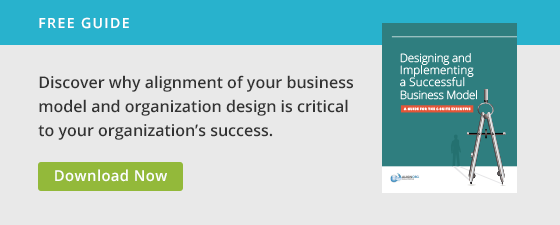At the HR Policy Association CHRO Summit, I had a chance to have lunch with the former CHRO of Procter & Gamble, Dick Antoine. Dick is also the former National Academy of Human Resources President. As a fellow professional charged with helping organizations design, implement and sustain transformational change, I was curious to hear his top three learnings from the CHRO chair about how organizations can successfully lead large-scale change.
Dick shared with me what, in his opinion, were the three most important aspects of implementing a successful organization change.
1. Make sure you connect your organizational design and/or change to strategy.
Dick has seen organizations over the course of his career make changes that weren’t anchored in strategy. He has seen change efforts languish when the heat was turned up and a strong marketplace rationale was not evident. Sometimes, functions are the worst culprits because they are inherently one or two steps removed from the end-customer, they have a tendency to undertake transformational efforts for what they perceive as their own good rather than the good of the end customer (or at least the business that is striving to deliver value to the customer).
I see the same thing as companies struggle to develop a strategy that truly drives marketplace differentiation. It can be difficult to make the tough choices necessary to create a strong strategy. However, much like a ship without a rudder, trying to implement change in an organization without a strong strategy in place can be distracting to the organization and frustrating to those being expected to change. Some of the hallmarks of good strategy include the following:
a.A specific target audience.
b. Clearly identified customer needs and how you will uniquely address them.
c. Clarity on the top channels for delivery.
d. Clear trade-offs—essentially identifying the good things that your organization will NOT do in order to free up resources, bandwidth, and focus for activities and efforts that will drive your differentiation to the targeted audience.
e. An eye focused on the revenue model.
2. Make sure the reason for change is clearly evident to everyone.
All employees should be able to answer the question, “Why do we need to do this?” You can’t mobilize around change unless people understand why it is necessary. Getting people to understand the rationale for change requires a simple, portable message that is repeated and reinforced throughout the organization again and again. Most large-scale change efforts have comprehensive communications plans, but Dick highlighted the importance of making the message simple, memorable and “sticky” – and then repeated again and again.
Our approach to developing a consistent message (or what we call a “core” message) demands clarity around the following:
a. Why the change is needed
b. What the end results will be
c. Who the critical stakeholders are
d. How to isolate and prioritize any behaviors impeding the change
e. What is the belief behind the impeding behavior
f. How will success be realized
g. What is a cogent “bottom line” statement that summarizes the earlier steps into an easily deliverable, memorable and meaningful message
The above process aligns the leadership around a concrete, consolidated core message that is tangible, simple, and most importantly, repeatable. From there, the message can cascade through the organization aligning thoughts and galvanizing action. As Dick casually said, “You need to repeat the message 100 times” to ensure that it is understood and accepted.
3. Make sure the executive team is aligned in how they think about the transformation and are resolved as a team to see it through publicly and privately.
It would be difficult to execute the first two suggestions without having everyone on the leadership team in lock step. In a recent engagement with a client, we had a small leadership team together to consolidate many processes as result of a divestiture. In the room, all seemed to be onboard, working together to create a solution. However, in private many of the leaders expressed doubts with regard to the rationale for the effort.
Of course, not all executives will agree with changes even if they tow the line in the end. Often, we think of change management as something to do for the targets of change who live down in the organization, but the same need for change management may apply to leaders as well (and perhaps even more so). Executives that want to undertake transformational change need to take the time to ensure alignment among top leaders. If there is dissent or just different ideas around the table, it may be worth the extra time to unpack the tough issues, work through the questions, and align thinking. Sometimes, an external change partner can help facilitate leadership teams through the transformation journey to help ensure they stay in sync and aligned so publicly and privately they are all singing out of the same hymn book.
Dick has clearly seen organization transformations first-hand. I want to thank him for sharing his practical advice and these three powerful keys so that CHROs, business executives and change practitioners alike can successfully support their organizations through transformational change.






